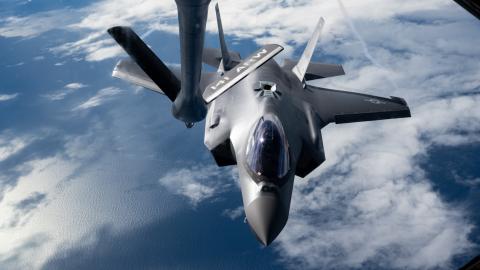Although range anxiety among electric vehicle drivers is diminishing, the US Air Force’s is only growing. At the Air & Space Forces Association’s Warfare Symposium earlier this month, Air Force leadership repeatedly emphasized the need to close gaps in their service’s capacity to affordably deliver lethal mass over long ranges.
The Air Force’s diminished fighter force now lacks the ability to sustain operations at scale over the vast dimensions of the Indo-Pacific and is increasingly out-sticked by China’s long-range air-to-air kill chains. And since the same kill chains will force the Air Force’s aerial refueling tankers to operate further from the fight, the fighter aircraft they support may not be able reach engagement areas that are located around the Taiwan Strait or spend much time once there.
Extending the reach and mission endurance of the Air Force’s fighters will be a key to resolving these shortfalls and creating the affordable mass that is needed to deter, and if necessary, defeat Chinese aggression. This will require the service to acquire cost-effective crewed and uncrewed combat systems and weapons — and do so in a time of compressed budgets.
Figuring out how to fight and win over long ranges while outnumbered is not new for the Air Force. America’s airmen confronted this challenge in the European theater during the Second World War and for much of the Cold War. Today, the Air Force faces a peer Indo-Pacific adversary that can generate superior combat mass and advanced capabilities during conflicts set on its periphery. Overcoming these disadvantages will require winning the sensing/counter-sensing competition with the PLA and developing command and control (C2) tools to achieve a decision advantage. But improving the quality of the Air Force’s sensors and C2 capabilities alone will not compensate for a lack of combat mass.
The good news is that the Air Force has a number of potential options underway, even if a silver bullet solution is elusive.
The Air Force has procured over 400 F-35As and intends to acquire hundreds more, so enhancing their range would positively impact the service’s combat operations for decades. The Air Force has elected to proceed with an Engine Core Upgrade that will significantly boost the F-35 engine’s power and cooling and modestly improve its range.
The Air Force is also developing a Next Generation Air Dominance (NGAD) fighter and uncrewed Collaborative Combat Aircraft (CCA) that could further extend the reach of its fighter forces. Long-range and low-signature NGAD will be capable of sustained operations throughout highly contested threat environments. However, given the cost of a single NGAD fighter will likely run into the hundreds of millions of dollars, it will be difficult to procure them at a high annual rate, and they will not be fielded at scale until the early 2030s. On the other hand, CCA with the range to accompany NGAD and F-35A into contested areas could be fielded in just a couple of years. But CCA will also be difficult to field at the required scale —hundreds and perhaps thousands — if they end up costing one quarter to one-third of an F-35.
Acquiring longer-range weapons is another, necessary option for developing a fighter force capable of projecting affordable mass at range. Weapons such as the AIM-260, an air-launched variant of the SM-6, or even longer-range missiles could give fighters longer reach. However, acquiring large numbers of very long-range high-cost weapons could be highly expensive and without complementary capabilities, make fighters dependent on extended kill chains vulnerable to disruption. At the other end of the spectrum, CCA like Longshot that will carry air-to-air missiles and can be air-launched or possibly ground-launched could increase the Air Force’s capacity to generate affordable mass at long ranges — again, provided they are sufficiently inexpensive and can survive to launch their missiles.
Developing stealthy tankers capable of penetrating contested zones to refuel US fighters is another option that could increase the Air Force’s capacity to project affordable mass at range. Aerial refueling enables shorter-legged combat aircraft to reach desired operating areas and increase their time on station. However, today’s aerial refueling force consists of non-stealthy aircraft that may need to operate hundreds of miles from the PLA’s advanced integrated air defenses. Stealthy tankers might do the trick, but they might also be expensive and therefore difficult to field in numbers. The cost of a stealthy tanker would also beg the question of why not spend the same funding to acquire additional NGAD and CCA that would deliver combat effects directly.
The answer to developing a future fighter force to deliver affordable mass at range will likely result from a mix of these four classes of options. To determine the right mix, the Air Force should leverage the expertise of its diverse combat forces and acquisition communities to assess promising combinations of these options. Consolidating the Air Force’s analytic expertise within its Secretariat is a constructive first step toward breaking down stovepipes among these communities and ensure its warfighters are directly engaged in determining the most promising solutions. Done correctly, the Air Force can sequence the delivery of affordable force packages that will present dilemmas to the PLA and other adversaries this decade instead of a theoretical 2030s-plus future.















